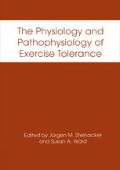Abstract
There is little question that the most disabling symptom of chronic pulmonary disease is exercise intolerance. The patient often becomes homebound, isolated and depressed out of fear of experiencing the dyspnea that exertion brings. The sedentary lifestyle these patients adopt only serves to make the situation worse. The inactive muscles atrophy, which increases the energetic cost of activity and, in fact, may increase dyspnea on exertion.
Access this chapter
Tax calculation will be finalised at checkout
Purchases are for personal use only
Preview
Unable to display preview. Download preview PDF.
References
American College of Sports Medicine. Position Stand. The recommended quantity and quality of exercise for developing and maintaining cardiorespiratory and muscular fitness in healthy adults. Med. Sci. Sports Exerc. 22: 265–274, 1990.
Belman, M.J. 7Ventilatory muscle training and unloading. In: Principles and Practice of Pulmonary Rehabilitation (Casaburi, R. and T.L. Petty, eds.), Philadelphia: Saunders, 1993, pp. 225–240.
Casaburi, R. Exercise training in chronic obstructive lung disease. In: Principles and Practice of Pulmonary Rehabilitation (Casaburi R., T.L. Petty, eds.), Philadelphia, Saunders, 1993; pp. 204–224.
Casaburi, R. Physiologic responses to training. Clinics in Chest Medicine 15: 215–227, 1994.
Casaburi, R. Deconditioning. In: Pulmonary Rehabilitation (Fishman, A.P. ed.), New York: Marcel Dekker (in press).
Casaburi, R., M. Burns, C. Cooper, E. Singer, R. Chang, and J. Porszasz. Physiological benefits of exercise training in severe COPD (Abstract). Am. J. Respir. Crit. Care Med. 149: A598, 1994.
Casaburi, R., A. Patessio, F. Ioli, S. Zanaboni, C.F. Donner, and K. Wasserman. Reduction in exercise lactic acidosis and ventilation as a result of exercise training in obstructive lung disease. Am. Rev. Respir. Dis. 143:9–18, 1991.
Casaburi, R., T.W. Storer, C.S. Sullivan, and K. Wasserman. Evaluation of blood lactate elevation as an intensity criterion for exercise training. Med. Sci. Sports Exerc. 27: 852–862, 1995.
Casaburi, R., T.W. Storer, and K. Wasserman. Mediation of reduced ventilatory response to exercise after endurance training.J. Appl. Physiol. 63: 1533–1538, 1987.
Copper, J.D., E.P. Trulock, A.N. Triantafillou, G.A Patterson, M.S. Pohl, P.A. Deloney, R.S. Sundaresan and C.L. Roper. Bilateral pneumectomy (volume reduction) for chronic obstructive pulmonary disease. J. Thoracic Cardiovasc. Surg. 109: 106–119, 1995.
Haas, F., J. Sasazar-Schicchi, and R. Axen. Desensitization to dyspnea in chronic obstructive pulmonary disease. In: Principles and Practice of Pulmonary Rehabilitation (Casaburi, R., TL Petty, eds.), Philadelphia, Saunders, pp. 241–251, 1993.
Saltin, B., and P.D. Gollnick. Skeletal muscle adaptability: significance for metabolism and performance. In: Handbook of Physiology. Skeletal Muscle (Am. Physiol. Soc), Washington, DC, pp. 555–631, 1983.
Stark, R.D. Dyspnoea: Assessment and pharmacological manipulation. Eur. Respir. J. 1: 290–287, 1988.
Stein, D.A., B.L. Bradley, and W.C. Miller. Mechanisms of oxygen effects on exercise in patients with chronic obstructive pulmonary disease. Chest 81: 6–10, 1982.
Sue, D.Y., K. Wasserman, R.B. Moricca, and R. Casaburi. Metabolic acidosis during exercise in patients with chronic obstructive pulmonary disease. Chest 94: 931–938, 1988.
Reis, A.L., and C.J. Archibald. Endurance exercise training at maximal targets in patients with chronic obstructive pulmonary disease. J. Cardiopulmon. Rehabil. 7: 594–601, 1987.
Wasserman, K., B.J. Whipp, and R. Casaburi. Respiratory control during exercise. In: Handbook of Physiology. Respiration II(Am. Physiol. Soc), Washington, DC, pp. 595–619, 1986.
Author information
Authors and Affiliations
Editor information
Editors and Affiliations
Rights and permissions
Copyright information
© 1996 Springer Science+Business Media New York
About this chapter
Cite this chapter
Casaburi, R. (1996). Enhancing Exercise Tolerance in Patients with Lung Disease. In: Steinacker, J.M., Ward, S.A. (eds) The Physiology and Pathophysiology of Exercise Tolerance. Springer, Boston, MA. https://doi.org/10.1007/978-1-4615-5887-3_40
Download citation
DOI: https://doi.org/10.1007/978-1-4615-5887-3_40
Publisher Name: Springer, Boston, MA
Print ISBN: 978-1-4613-7700-9
Online ISBN: 978-1-4615-5887-3
eBook Packages: Springer Book Archive

